HR Project 1: High Performance Working and Performance Management
VerifiedAdded on 2023/01/09
|15
|5102
|21
Report
AI Summary
This report provides a comprehensive analysis of high-performance working (HPW) and its practical application within the context of Tesco, a leading retail company. The report delves into the core components of HPW, emphasizing employee security, effective hiring strategies, decision-making processes, training and development initiatives, and the promotion of innovation. It further explores the crucial link between HPW and organizational performance, highlighting how HPW practices can drive improved financial outcomes and competitive advantages. Additionally, the report identifies and discusses the various barriers that can impede the successful implementation of HPW, such as a lack of employee involvement, poor communication, inadequate organizational structure, and inefficient performance management systems. The report also examines the stages of the performance management cycle and provides examples of how line managers can be involved in the performance review process. Finally, the report offers insights into how to sustain a culture of HPW, emphasizing the importance of continuous improvement and employee engagement.
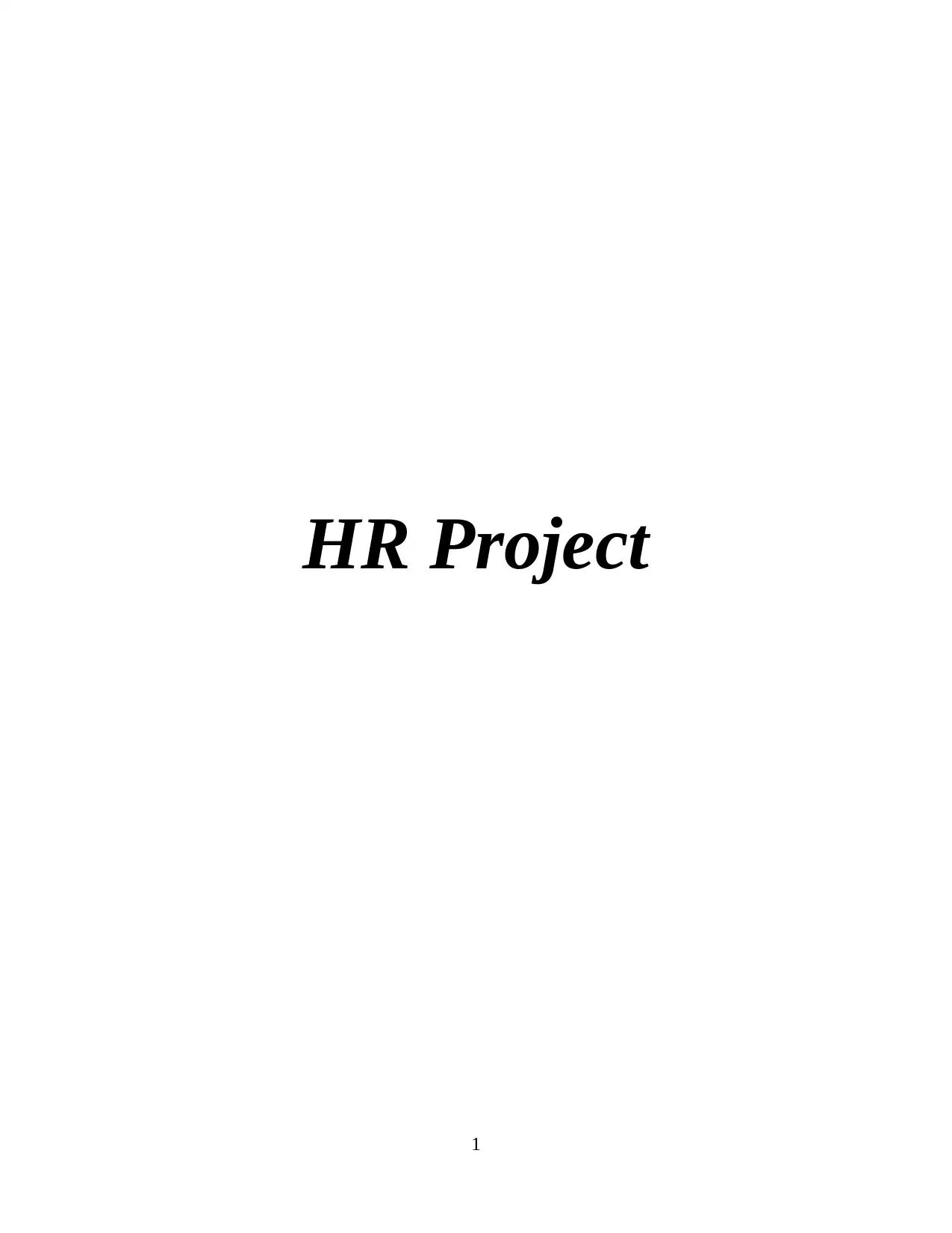
HR Project
1
1
Paraphrase This Document
Need a fresh take? Get an instant paraphrase of this document with our AI Paraphraser
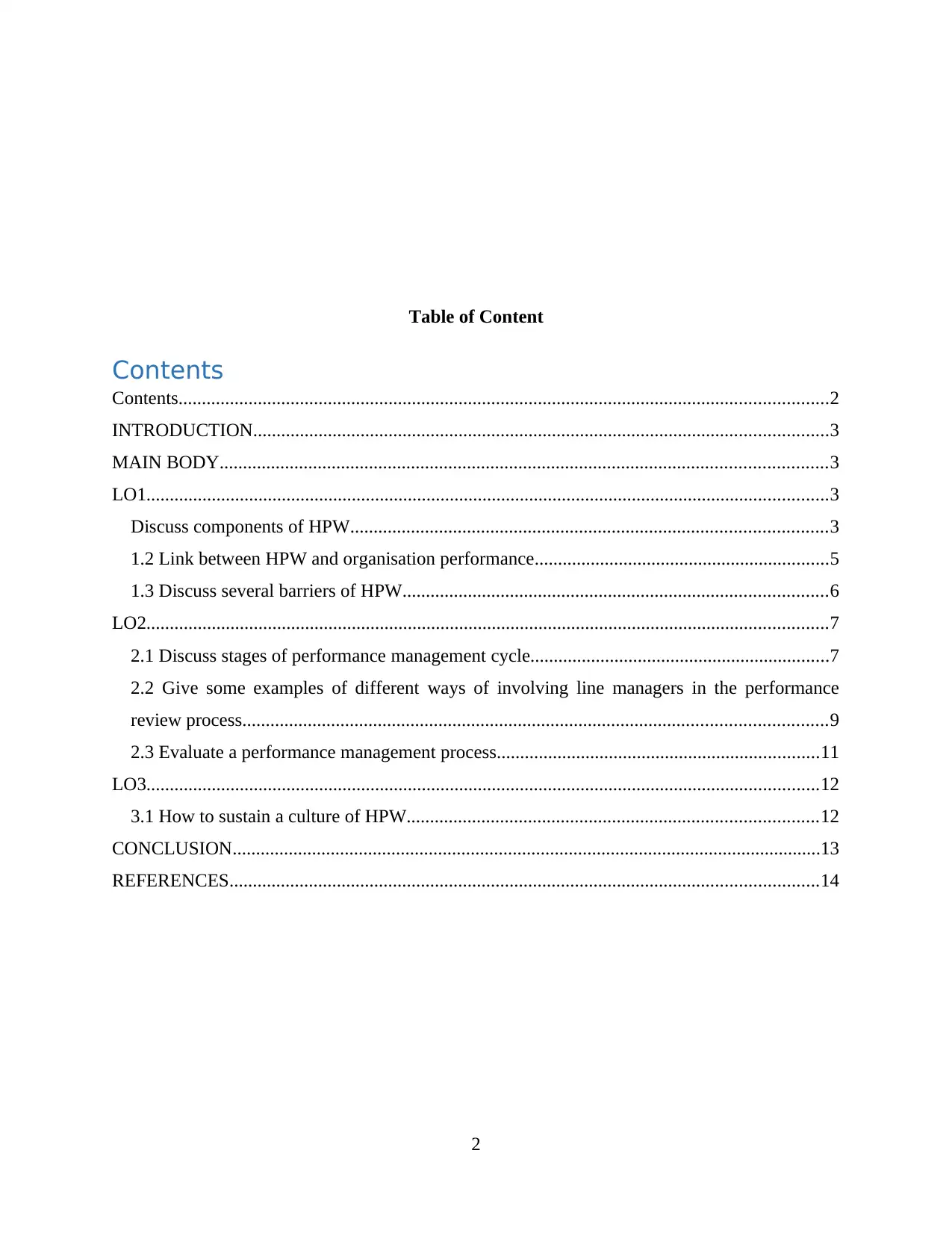
Table of Content
Contents
Contents...........................................................................................................................................2
INTRODUCTION...........................................................................................................................3
MAIN BODY..................................................................................................................................3
LO1..................................................................................................................................................3
Discuss components of HPW......................................................................................................3
1.2 Link between HPW and organisation performance...............................................................5
1.3 Discuss several barriers of HPW...........................................................................................6
LO2..................................................................................................................................................7
2.1 Discuss stages of performance management cycle................................................................7
2.2 Give some examples of different ways of involving line managers in the performance
review process.............................................................................................................................9
2.3 Evaluate a performance management process.....................................................................11
LO3................................................................................................................................................12
3.1 How to sustain a culture of HPW........................................................................................12
CONCLUSION..............................................................................................................................13
REFERENCES..............................................................................................................................14
2
Contents
Contents...........................................................................................................................................2
INTRODUCTION...........................................................................................................................3
MAIN BODY..................................................................................................................................3
LO1..................................................................................................................................................3
Discuss components of HPW......................................................................................................3
1.2 Link between HPW and organisation performance...............................................................5
1.3 Discuss several barriers of HPW...........................................................................................6
LO2..................................................................................................................................................7
2.1 Discuss stages of performance management cycle................................................................7
2.2 Give some examples of different ways of involving line managers in the performance
review process.............................................................................................................................9
2.3 Evaluate a performance management process.....................................................................11
LO3................................................................................................................................................12
3.1 How to sustain a culture of HPW........................................................................................12
CONCLUSION..............................................................................................................................13
REFERENCES..............................................................................................................................14
2
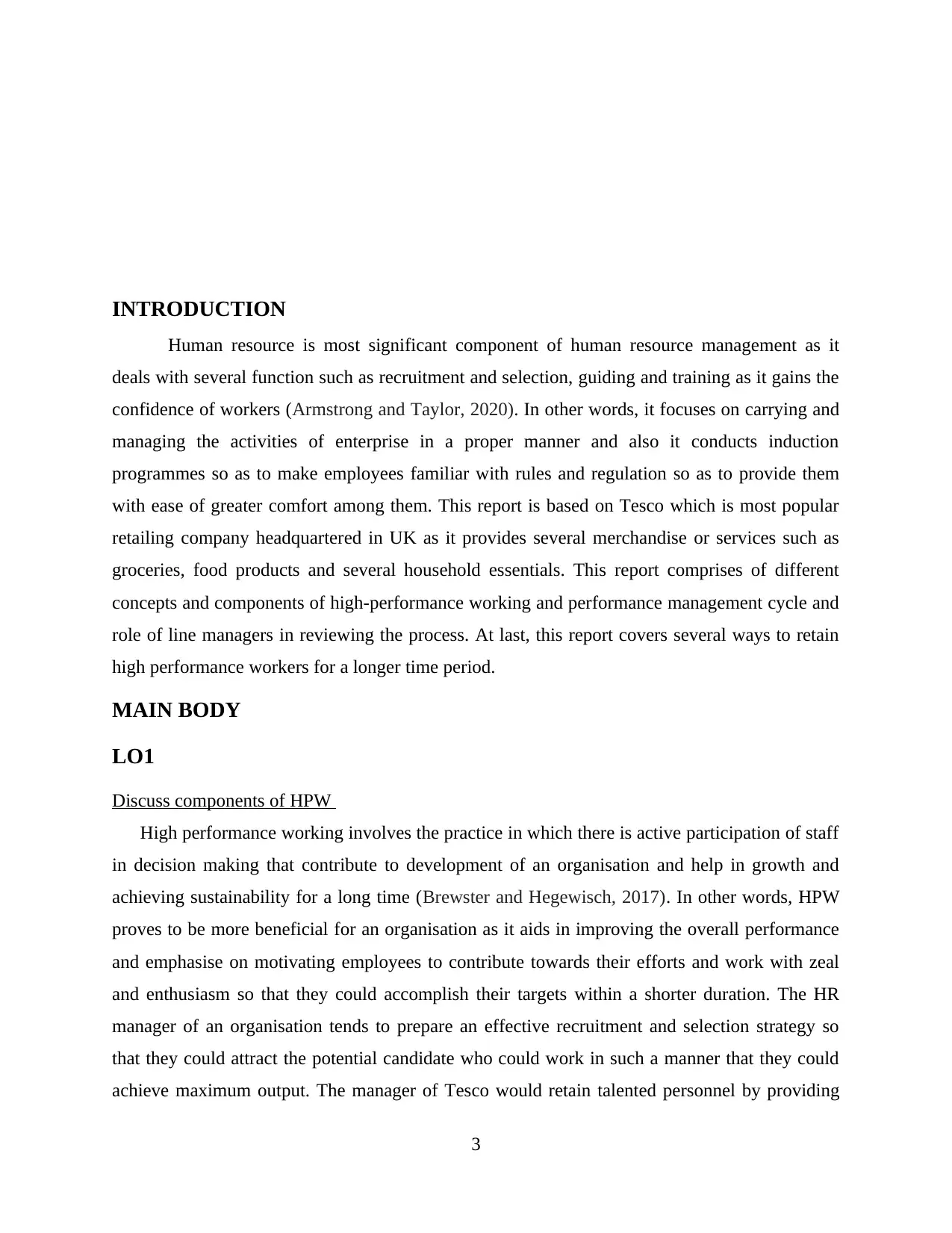
INTRODUCTION
Human resource is most significant component of human resource management as it
deals with several function such as recruitment and selection, guiding and training as it gains the
confidence of workers (Armstrong and Taylor, 2020). In other words, it focuses on carrying and
managing the activities of enterprise in a proper manner and also it conducts induction
programmes so as to make employees familiar with rules and regulation so as to provide them
with ease of greater comfort among them. This report is based on Tesco which is most popular
retailing company headquartered in UK as it provides several merchandise or services such as
groceries, food products and several household essentials. This report comprises of different
concepts and components of high-performance working and performance management cycle and
role of line managers in reviewing the process. At last, this report covers several ways to retain
high performance workers for a longer time period.
MAIN BODY
LO1
Discuss components of HPW
High performance working involves the practice in which there is active participation of staff
in decision making that contribute to development of an organisation and help in growth and
achieving sustainability for a long time (Brewster and Hegewisch, 2017). In other words, HPW
proves to be more beneficial for an organisation as it aids in improving the overall performance
and emphasise on motivating employees to contribute towards their efforts and work with zeal
and enthusiasm so that they could accomplish their targets within a shorter duration. The HR
manager of an organisation tends to prepare an effective recruitment and selection strategy so
that they could attract the potential candidate who could work in such a manner that they could
achieve maximum output. The manager of Tesco would retain talented personnel by providing
3
Human resource is most significant component of human resource management as it
deals with several function such as recruitment and selection, guiding and training as it gains the
confidence of workers (Armstrong and Taylor, 2020). In other words, it focuses on carrying and
managing the activities of enterprise in a proper manner and also it conducts induction
programmes so as to make employees familiar with rules and regulation so as to provide them
with ease of greater comfort among them. This report is based on Tesco which is most popular
retailing company headquartered in UK as it provides several merchandise or services such as
groceries, food products and several household essentials. This report comprises of different
concepts and components of high-performance working and performance management cycle and
role of line managers in reviewing the process. At last, this report covers several ways to retain
high performance workers for a longer time period.
MAIN BODY
LO1
Discuss components of HPW
High performance working involves the practice in which there is active participation of staff
in decision making that contribute to development of an organisation and help in growth and
achieving sustainability for a long time (Brewster and Hegewisch, 2017). In other words, HPW
proves to be more beneficial for an organisation as it aids in improving the overall performance
and emphasise on motivating employees to contribute towards their efforts and work with zeal
and enthusiasm so that they could accomplish their targets within a shorter duration. The HR
manager of an organisation tends to prepare an effective recruitment and selection strategy so
that they could attract the potential candidate who could work in such a manner that they could
achieve maximum output. The manager of Tesco would retain talented personnel by providing
3
⊘ This is a preview!⊘
Do you want full access?
Subscribe today to unlock all pages.

Trusted by 1+ million students worldwide
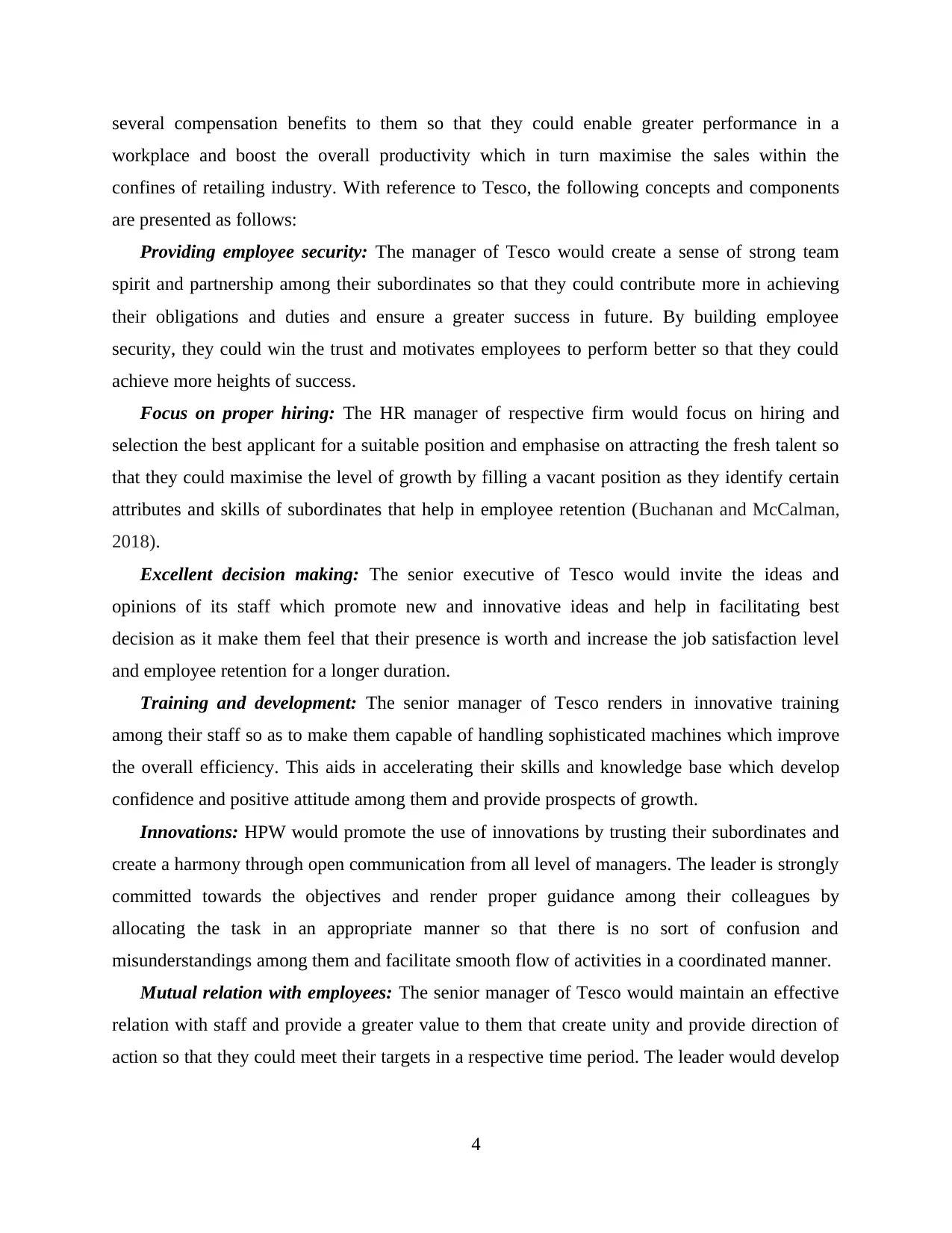
several compensation benefits to them so that they could enable greater performance in a
workplace and boost the overall productivity which in turn maximise the sales within the
confines of retailing industry. With reference to Tesco, the following concepts and components
are presented as follows:
Providing employee security: The manager of Tesco would create a sense of strong team
spirit and partnership among their subordinates so that they could contribute more in achieving
their obligations and duties and ensure a greater success in future. By building employee
security, they could win the trust and motivates employees to perform better so that they could
achieve more heights of success.
Focus on proper hiring: The HR manager of respective firm would focus on hiring and
selection the best applicant for a suitable position and emphasise on attracting the fresh talent so
that they could maximise the level of growth by filling a vacant position as they identify certain
attributes and skills of subordinates that help in employee retention (Buchanan and McCalman,
2018).
Excellent decision making: The senior executive of Tesco would invite the ideas and
opinions of its staff which promote new and innovative ideas and help in facilitating best
decision as it make them feel that their presence is worth and increase the job satisfaction level
and employee retention for a longer duration.
Training and development: The senior manager of Tesco renders in innovative training
among their staff so as to make them capable of handling sophisticated machines which improve
the overall efficiency. This aids in accelerating their skills and knowledge base which develop
confidence and positive attitude among them and provide prospects of growth.
Innovations: HPW would promote the use of innovations by trusting their subordinates and
create a harmony through open communication from all level of managers. The leader is strongly
committed towards the objectives and render proper guidance among their colleagues by
allocating the task in an appropriate manner so that there is no sort of confusion and
misunderstandings among them and facilitate smooth flow of activities in a coordinated manner.
Mutual relation with employees: The senior manager of Tesco would maintain an effective
relation with staff and provide a greater value to them that create unity and provide direction of
action so that they could meet their targets in a respective time period. The leader would develop
4
workplace and boost the overall productivity which in turn maximise the sales within the
confines of retailing industry. With reference to Tesco, the following concepts and components
are presented as follows:
Providing employee security: The manager of Tesco would create a sense of strong team
spirit and partnership among their subordinates so that they could contribute more in achieving
their obligations and duties and ensure a greater success in future. By building employee
security, they could win the trust and motivates employees to perform better so that they could
achieve more heights of success.
Focus on proper hiring: The HR manager of respective firm would focus on hiring and
selection the best applicant for a suitable position and emphasise on attracting the fresh talent so
that they could maximise the level of growth by filling a vacant position as they identify certain
attributes and skills of subordinates that help in employee retention (Buchanan and McCalman,
2018).
Excellent decision making: The senior executive of Tesco would invite the ideas and
opinions of its staff which promote new and innovative ideas and help in facilitating best
decision as it make them feel that their presence is worth and increase the job satisfaction level
and employee retention for a longer duration.
Training and development: The senior manager of Tesco renders in innovative training
among their staff so as to make them capable of handling sophisticated machines which improve
the overall efficiency. This aids in accelerating their skills and knowledge base which develop
confidence and positive attitude among them and provide prospects of growth.
Innovations: HPW would promote the use of innovations by trusting their subordinates and
create a harmony through open communication from all level of managers. The leader is strongly
committed towards the objectives and render proper guidance among their colleagues by
allocating the task in an appropriate manner so that there is no sort of confusion and
misunderstandings among them and facilitate smooth flow of activities in a coordinated manner.
Mutual relation with employees: The senior manager of Tesco would maintain an effective
relation with staff and provide a greater value to them that create unity and provide direction of
action so that they could meet their targets in a respective time period. The leader would develop
4
Paraphrase This Document
Need a fresh take? Get an instant paraphrase of this document with our AI Paraphraser
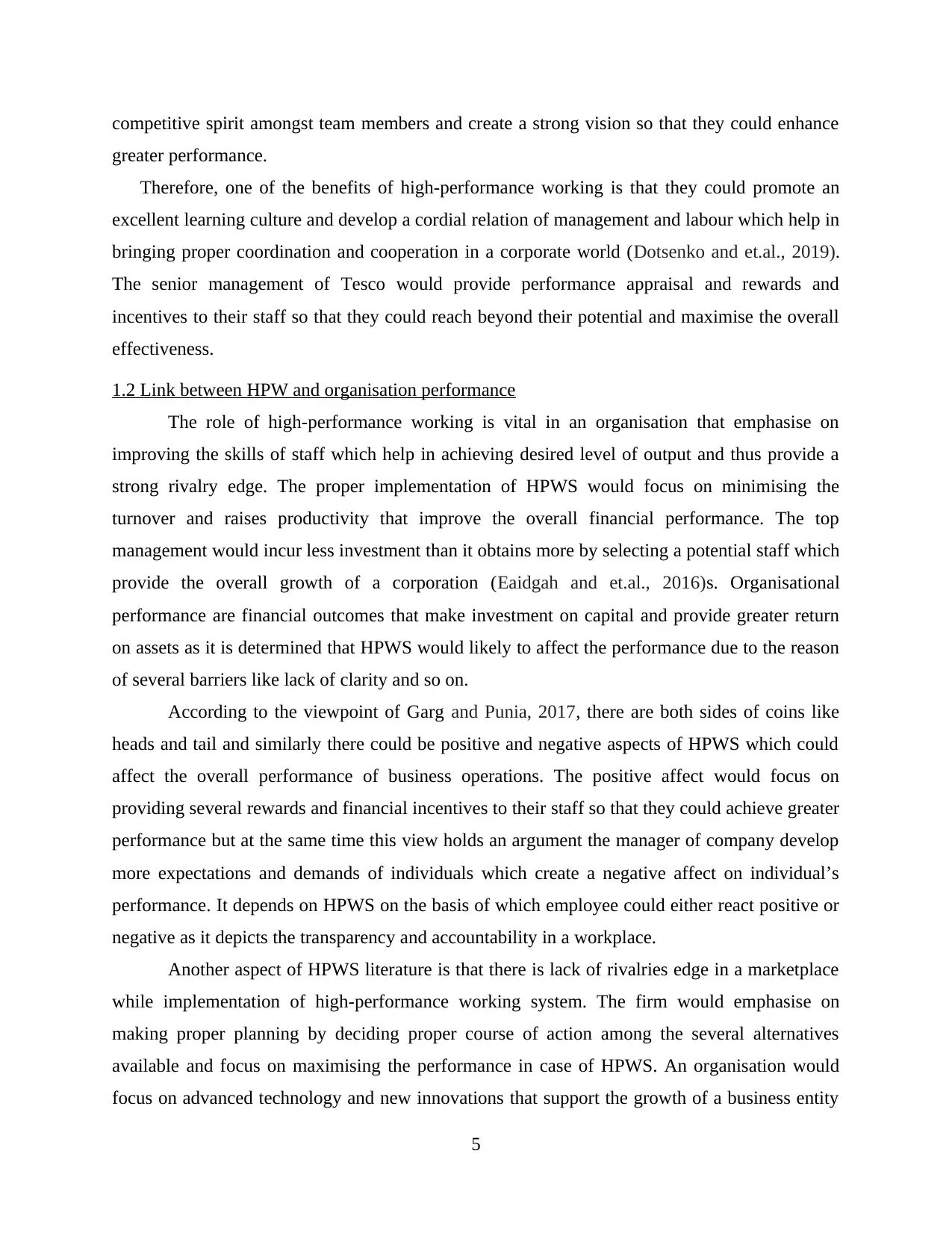
competitive spirit amongst team members and create a strong vision so that they could enhance
greater performance.
Therefore, one of the benefits of high-performance working is that they could promote an
excellent learning culture and develop a cordial relation of management and labour which help in
bringing proper coordination and cooperation in a corporate world (Dotsenko and et.al., 2019).
The senior management of Tesco would provide performance appraisal and rewards and
incentives to their staff so that they could reach beyond their potential and maximise the overall
effectiveness.
1.2 Link between HPW and organisation performance
The role of high-performance working is vital in an organisation that emphasise on
improving the skills of staff which help in achieving desired level of output and thus provide a
strong rivalry edge. The proper implementation of HPWS would focus on minimising the
turnover and raises productivity that improve the overall financial performance. The top
management would incur less investment than it obtains more by selecting a potential staff which
provide the overall growth of a corporation (Eaidgah and et.al., 2016)s. Organisational
performance are financial outcomes that make investment on capital and provide greater return
on assets as it is determined that HPWS would likely to affect the performance due to the reason
of several barriers like lack of clarity and so on.
According to the viewpoint of Garg and Punia, 2017, there are both sides of coins like
heads and tail and similarly there could be positive and negative aspects of HPWS which could
affect the overall performance of business operations. The positive affect would focus on
providing several rewards and financial incentives to their staff so that they could achieve greater
performance but at the same time this view holds an argument the manager of company develop
more expectations and demands of individuals which create a negative affect on individual’s
performance. It depends on HPWS on the basis of which employee could either react positive or
negative as it depicts the transparency and accountability in a workplace.
Another aspect of HPWS literature is that there is lack of rivalries edge in a marketplace
while implementation of high-performance working system. The firm would emphasise on
making proper planning by deciding proper course of action among the several alternatives
available and focus on maximising the performance in case of HPWS. An organisation would
focus on advanced technology and new innovations that support the growth of a business entity
5
greater performance.
Therefore, one of the benefits of high-performance working is that they could promote an
excellent learning culture and develop a cordial relation of management and labour which help in
bringing proper coordination and cooperation in a corporate world (Dotsenko and et.al., 2019).
The senior management of Tesco would provide performance appraisal and rewards and
incentives to their staff so that they could reach beyond their potential and maximise the overall
effectiveness.
1.2 Link between HPW and organisation performance
The role of high-performance working is vital in an organisation that emphasise on
improving the skills of staff which help in achieving desired level of output and thus provide a
strong rivalry edge. The proper implementation of HPWS would focus on minimising the
turnover and raises productivity that improve the overall financial performance. The top
management would incur less investment than it obtains more by selecting a potential staff which
provide the overall growth of a corporation (Eaidgah and et.al., 2016)s. Organisational
performance are financial outcomes that make investment on capital and provide greater return
on assets as it is determined that HPWS would likely to affect the performance due to the reason
of several barriers like lack of clarity and so on.
According to the viewpoint of Garg and Punia, 2017, there are both sides of coins like
heads and tail and similarly there could be positive and negative aspects of HPWS which could
affect the overall performance of business operations. The positive affect would focus on
providing several rewards and financial incentives to their staff so that they could achieve greater
performance but at the same time this view holds an argument the manager of company develop
more expectations and demands of individuals which create a negative affect on individual’s
performance. It depends on HPWS on the basis of which employee could either react positive or
negative as it depicts the transparency and accountability in a workplace.
Another aspect of HPWS literature is that there is lack of rivalries edge in a marketplace
while implementation of high-performance working system. The firm would emphasise on
making proper planning by deciding proper course of action among the several alternatives
available and focus on maximising the performance in case of HPWS. An organisation would
focus on advanced technology and new innovations that support the growth of a business entity
5
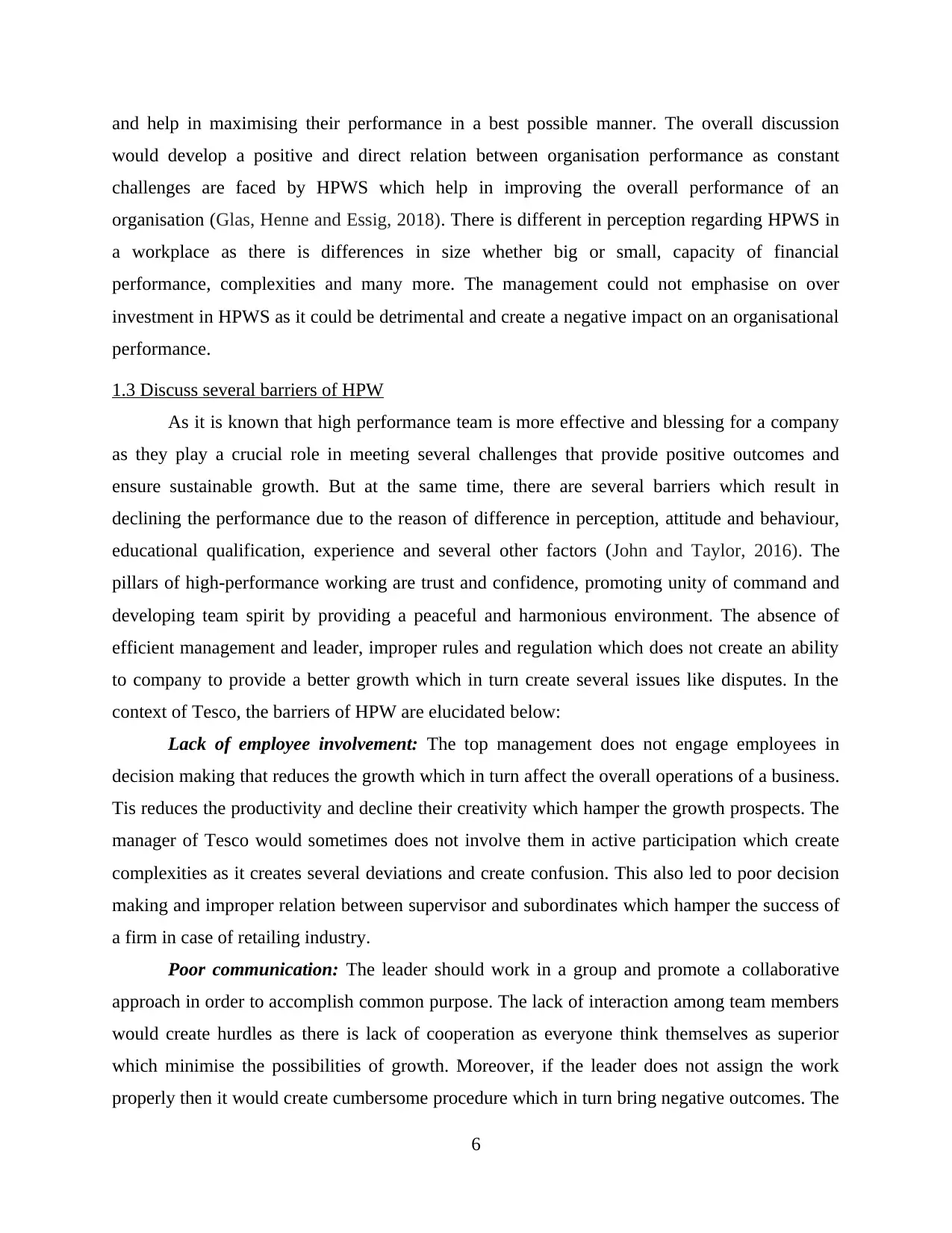
and help in maximising their performance in a best possible manner. The overall discussion
would develop a positive and direct relation between organisation performance as constant
challenges are faced by HPWS which help in improving the overall performance of an
organisation (Glas, Henne and Essig, 2018). There is different in perception regarding HPWS in
a workplace as there is differences in size whether big or small, capacity of financial
performance, complexities and many more. The management could not emphasise on over
investment in HPWS as it could be detrimental and create a negative impact on an organisational
performance.
1.3 Discuss several barriers of HPW
As it is known that high performance team is more effective and blessing for a company
as they play a crucial role in meeting several challenges that provide positive outcomes and
ensure sustainable growth. But at the same time, there are several barriers which result in
declining the performance due to the reason of difference in perception, attitude and behaviour,
educational qualification, experience and several other factors (John and Taylor, 2016). The
pillars of high-performance working are trust and confidence, promoting unity of command and
developing team spirit by providing a peaceful and harmonious environment. The absence of
efficient management and leader, improper rules and regulation which does not create an ability
to company to provide a better growth which in turn create several issues like disputes. In the
context of Tesco, the barriers of HPW are elucidated below:
Lack of employee involvement: The top management does not engage employees in
decision making that reduces the growth which in turn affect the overall operations of a business.
Tis reduces the productivity and decline their creativity which hamper the growth prospects. The
manager of Tesco would sometimes does not involve them in active participation which create
complexities as it creates several deviations and create confusion. This also led to poor decision
making and improper relation between supervisor and subordinates which hamper the success of
a firm in case of retailing industry.
Poor communication: The leader should work in a group and promote a collaborative
approach in order to accomplish common purpose. The lack of interaction among team members
would create hurdles as there is lack of cooperation as everyone think themselves as superior
which minimise the possibilities of growth. Moreover, if the leader does not assign the work
properly then it would create cumbersome procedure which in turn bring negative outcomes. The
6
would develop a positive and direct relation between organisation performance as constant
challenges are faced by HPWS which help in improving the overall performance of an
organisation (Glas, Henne and Essig, 2018). There is different in perception regarding HPWS in
a workplace as there is differences in size whether big or small, capacity of financial
performance, complexities and many more. The management could not emphasise on over
investment in HPWS as it could be detrimental and create a negative impact on an organisational
performance.
1.3 Discuss several barriers of HPW
As it is known that high performance team is more effective and blessing for a company
as they play a crucial role in meeting several challenges that provide positive outcomes and
ensure sustainable growth. But at the same time, there are several barriers which result in
declining the performance due to the reason of difference in perception, attitude and behaviour,
educational qualification, experience and several other factors (John and Taylor, 2016). The
pillars of high-performance working are trust and confidence, promoting unity of command and
developing team spirit by providing a peaceful and harmonious environment. The absence of
efficient management and leader, improper rules and regulation which does not create an ability
to company to provide a better growth which in turn create several issues like disputes. In the
context of Tesco, the barriers of HPW are elucidated below:
Lack of employee involvement: The top management does not engage employees in
decision making that reduces the growth which in turn affect the overall operations of a business.
Tis reduces the productivity and decline their creativity which hamper the growth prospects. The
manager of Tesco would sometimes does not involve them in active participation which create
complexities as it creates several deviations and create confusion. This also led to poor decision
making and improper relation between supervisor and subordinates which hamper the success of
a firm in case of retailing industry.
Poor communication: The leader should work in a group and promote a collaborative
approach in order to accomplish common purpose. The lack of interaction among team members
would create hurdles as there is lack of cooperation as everyone think themselves as superior
which minimise the possibilities of growth. Moreover, if the leader does not assign the work
properly then it would create cumbersome procedure which in turn bring negative outcomes. The
6
⊘ This is a preview!⊘
Do you want full access?
Subscribe today to unlock all pages.

Trusted by 1+ million students worldwide
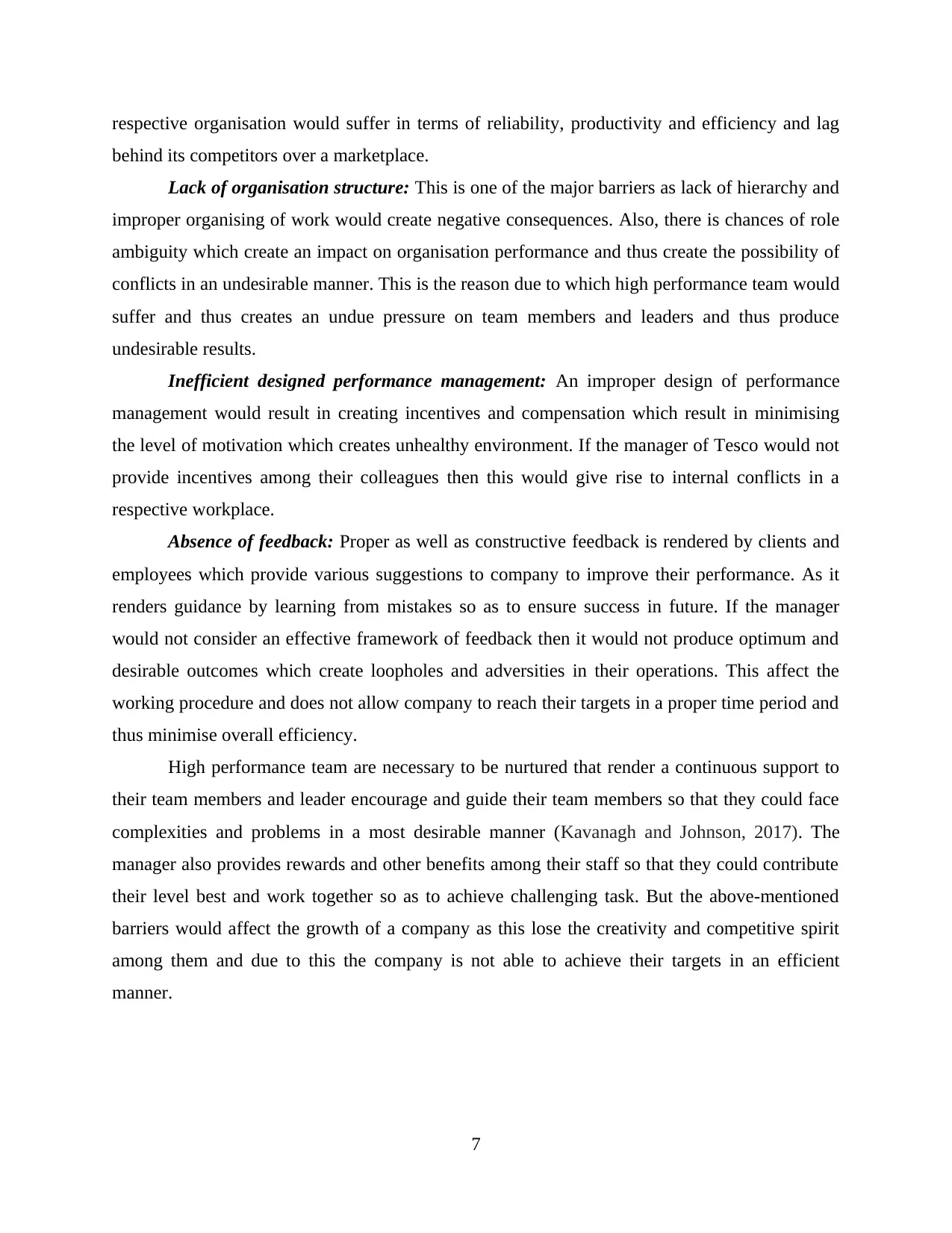
respective organisation would suffer in terms of reliability, productivity and efficiency and lag
behind its competitors over a marketplace.
Lack of organisation structure: This is one of the major barriers as lack of hierarchy and
improper organising of work would create negative consequences. Also, there is chances of role
ambiguity which create an impact on organisation performance and thus create the possibility of
conflicts in an undesirable manner. This is the reason due to which high performance team would
suffer and thus creates an undue pressure on team members and leaders and thus produce
undesirable results.
Inefficient designed performance management: An improper design of performance
management would result in creating incentives and compensation which result in minimising
the level of motivation which creates unhealthy environment. If the manager of Tesco would not
provide incentives among their colleagues then this would give rise to internal conflicts in a
respective workplace.
Absence of feedback: Proper as well as constructive feedback is rendered by clients and
employees which provide various suggestions to company to improve their performance. As it
renders guidance by learning from mistakes so as to ensure success in future. If the manager
would not consider an effective framework of feedback then it would not produce optimum and
desirable outcomes which create loopholes and adversities in their operations. This affect the
working procedure and does not allow company to reach their targets in a proper time period and
thus minimise overall efficiency.
High performance team are necessary to be nurtured that render a continuous support to
their team members and leader encourage and guide their team members so that they could face
complexities and problems in a most desirable manner (Kavanagh and Johnson, 2017). The
manager also provides rewards and other benefits among their staff so that they could contribute
their level best and work together so as to achieve challenging task. But the above-mentioned
barriers would affect the growth of a company as this lose the creativity and competitive spirit
among them and due to this the company is not able to achieve their targets in an efficient
manner.
7
behind its competitors over a marketplace.
Lack of organisation structure: This is one of the major barriers as lack of hierarchy and
improper organising of work would create negative consequences. Also, there is chances of role
ambiguity which create an impact on organisation performance and thus create the possibility of
conflicts in an undesirable manner. This is the reason due to which high performance team would
suffer and thus creates an undue pressure on team members and leaders and thus produce
undesirable results.
Inefficient designed performance management: An improper design of performance
management would result in creating incentives and compensation which result in minimising
the level of motivation which creates unhealthy environment. If the manager of Tesco would not
provide incentives among their colleagues then this would give rise to internal conflicts in a
respective workplace.
Absence of feedback: Proper as well as constructive feedback is rendered by clients and
employees which provide various suggestions to company to improve their performance. As it
renders guidance by learning from mistakes so as to ensure success in future. If the manager
would not consider an effective framework of feedback then it would not produce optimum and
desirable outcomes which create loopholes and adversities in their operations. This affect the
working procedure and does not allow company to reach their targets in a proper time period and
thus minimise overall efficiency.
High performance team are necessary to be nurtured that render a continuous support to
their team members and leader encourage and guide their team members so that they could face
complexities and problems in a most desirable manner (Kavanagh and Johnson, 2017). The
manager also provides rewards and other benefits among their staff so that they could contribute
their level best and work together so as to achieve challenging task. But the above-mentioned
barriers would affect the growth of a company as this lose the creativity and competitive spirit
among them and due to this the company is not able to achieve their targets in an efficient
manner.
7
Paraphrase This Document
Need a fresh take? Get an instant paraphrase of this document with our AI Paraphraser
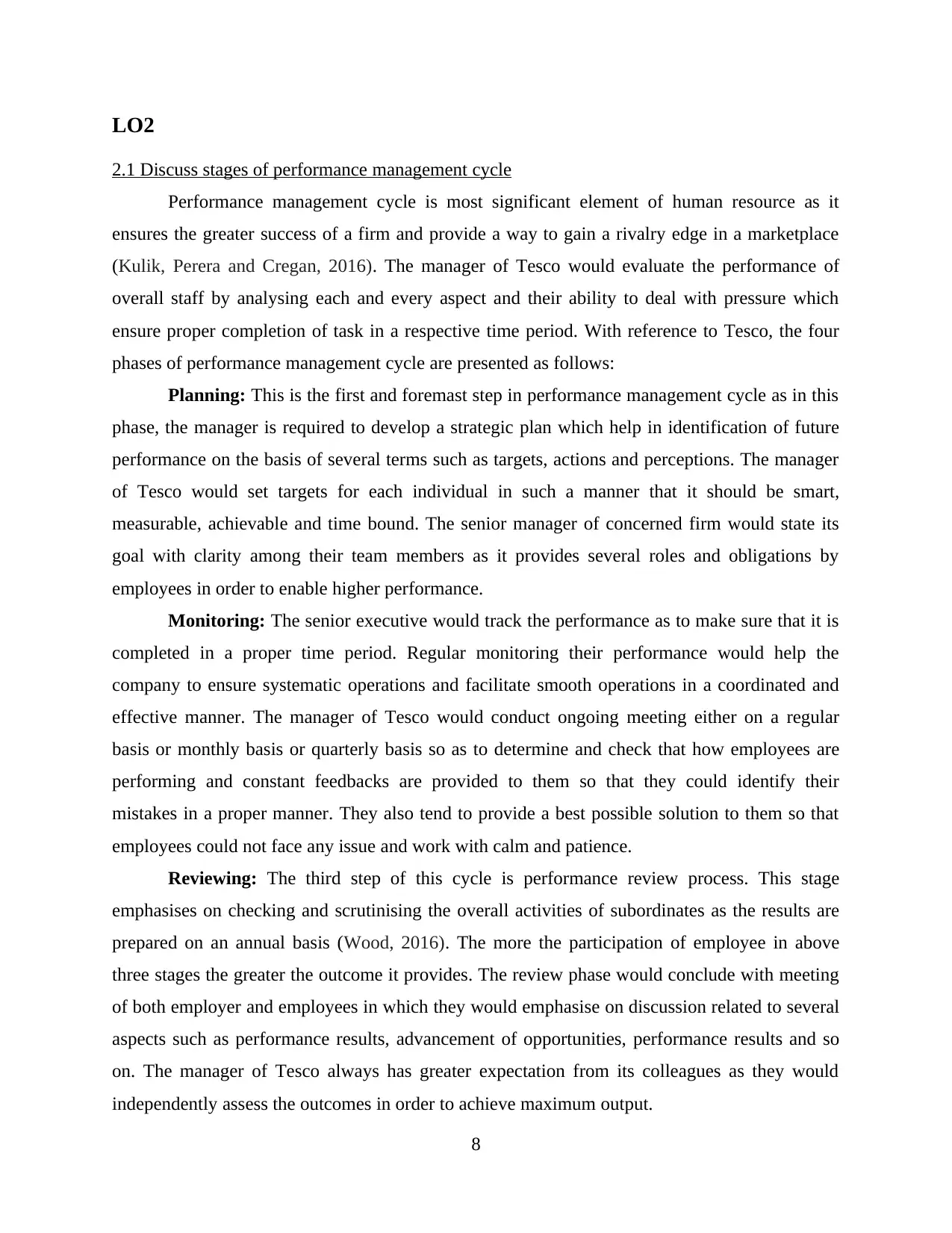
LO2
2.1 Discuss stages of performance management cycle
Performance management cycle is most significant element of human resource as it
ensures the greater success of a firm and provide a way to gain a rivalry edge in a marketplace
(Kulik, Perera and Cregan, 2016). The manager of Tesco would evaluate the performance of
overall staff by analysing each and every aspect and their ability to deal with pressure which
ensure proper completion of task in a respective time period. With reference to Tesco, the four
phases of performance management cycle are presented as follows:
Planning: This is the first and foremast step in performance management cycle as in this
phase, the manager is required to develop a strategic plan which help in identification of future
performance on the basis of several terms such as targets, actions and perceptions. The manager
of Tesco would set targets for each individual in such a manner that it should be smart,
measurable, achievable and time bound. The senior manager of concerned firm would state its
goal with clarity among their team members as it provides several roles and obligations by
employees in order to enable higher performance.
Monitoring: The senior executive would track the performance as to make sure that it is
completed in a proper time period. Regular monitoring their performance would help the
company to ensure systematic operations and facilitate smooth operations in a coordinated and
effective manner. The manager of Tesco would conduct ongoing meeting either on a regular
basis or monthly basis or quarterly basis so as to determine and check that how employees are
performing and constant feedbacks are provided to them so that they could identify their
mistakes in a proper manner. They also tend to provide a best possible solution to them so that
employees could not face any issue and work with calm and patience.
Reviewing: The third step of this cycle is performance review process. This stage
emphasises on checking and scrutinising the overall activities of subordinates as the results are
prepared on an annual basis (Wood, 2016). The more the participation of employee in above
three stages the greater the outcome it provides. The review phase would conclude with meeting
of both employer and employees in which they would emphasise on discussion related to several
aspects such as performance results, advancement of opportunities, performance results and so
on. The manager of Tesco always has greater expectation from its colleagues as they would
independently assess the outcomes in order to achieve maximum output.
8
2.1 Discuss stages of performance management cycle
Performance management cycle is most significant element of human resource as it
ensures the greater success of a firm and provide a way to gain a rivalry edge in a marketplace
(Kulik, Perera and Cregan, 2016). The manager of Tesco would evaluate the performance of
overall staff by analysing each and every aspect and their ability to deal with pressure which
ensure proper completion of task in a respective time period. With reference to Tesco, the four
phases of performance management cycle are presented as follows:
Planning: This is the first and foremast step in performance management cycle as in this
phase, the manager is required to develop a strategic plan which help in identification of future
performance on the basis of several terms such as targets, actions and perceptions. The manager
of Tesco would set targets for each individual in such a manner that it should be smart,
measurable, achievable and time bound. The senior manager of concerned firm would state its
goal with clarity among their team members as it provides several roles and obligations by
employees in order to enable higher performance.
Monitoring: The senior executive would track the performance as to make sure that it is
completed in a proper time period. Regular monitoring their performance would help the
company to ensure systematic operations and facilitate smooth operations in a coordinated and
effective manner. The manager of Tesco would conduct ongoing meeting either on a regular
basis or monthly basis or quarterly basis so as to determine and check that how employees are
performing and constant feedbacks are provided to them so that they could identify their
mistakes in a proper manner. They also tend to provide a best possible solution to them so that
employees could not face any issue and work with calm and patience.
Reviewing: The third step of this cycle is performance review process. This stage
emphasises on checking and scrutinising the overall activities of subordinates as the results are
prepared on an annual basis (Wood, 2016). The more the participation of employee in above
three stages the greater the outcome it provides. The review phase would conclude with meeting
of both employer and employees in which they would emphasise on discussion related to several
aspects such as performance results, advancement of opportunities, performance results and so
on. The manager of Tesco always has greater expectation from its colleagues as they would
independently assess the outcomes in order to achieve maximum output.
8
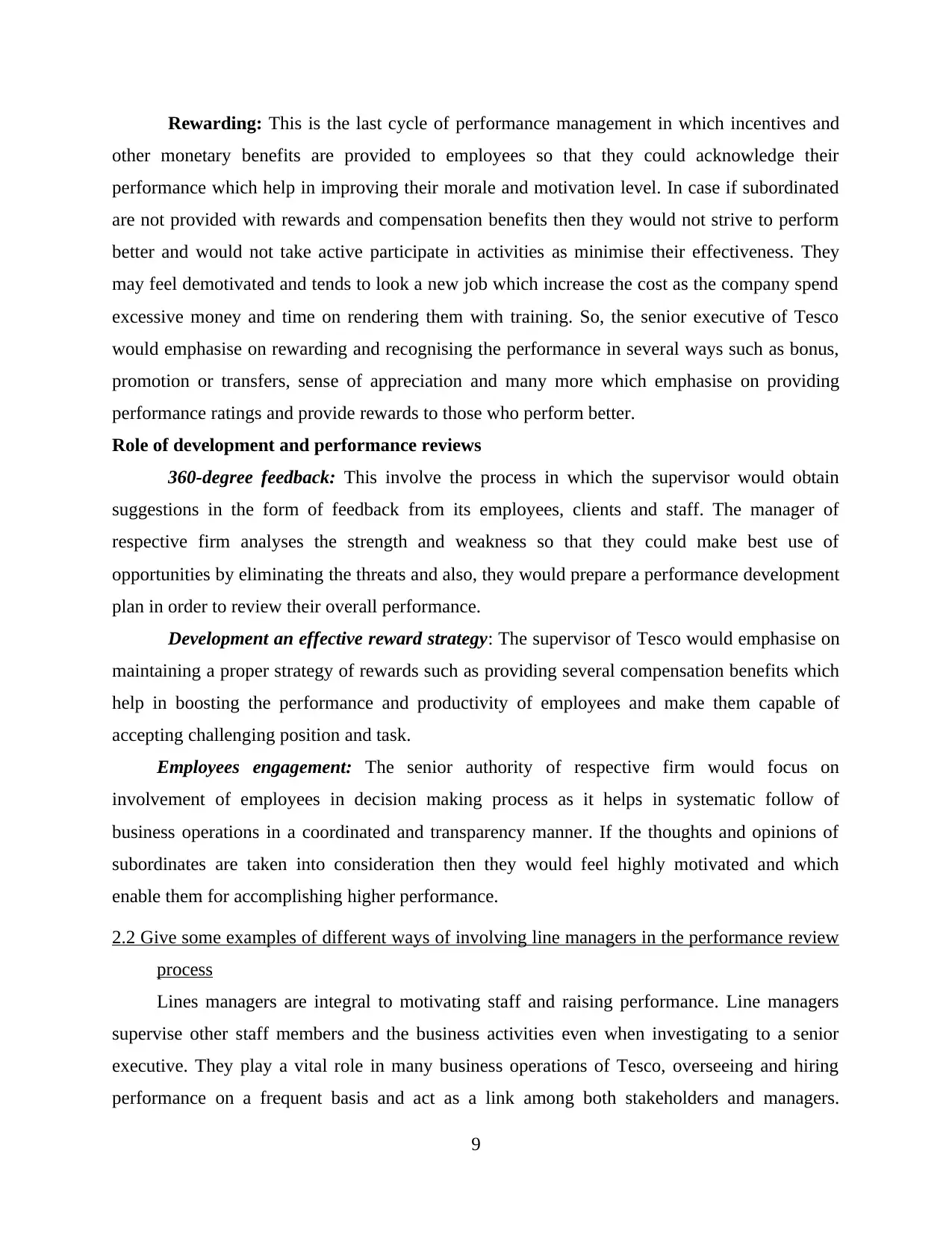
Rewarding: This is the last cycle of performance management in which incentives and
other monetary benefits are provided to employees so that they could acknowledge their
performance which help in improving their morale and motivation level. In case if subordinated
are not provided with rewards and compensation benefits then they would not strive to perform
better and would not take active participate in activities as minimise their effectiveness. They
may feel demotivated and tends to look a new job which increase the cost as the company spend
excessive money and time on rendering them with training. So, the senior executive of Tesco
would emphasise on rewarding and recognising the performance in several ways such as bonus,
promotion or transfers, sense of appreciation and many more which emphasise on providing
performance ratings and provide rewards to those who perform better.
Role of development and performance reviews
360-degree feedback: This involve the process in which the supervisor would obtain
suggestions in the form of feedback from its employees, clients and staff. The manager of
respective firm analyses the strength and weakness so that they could make best use of
opportunities by eliminating the threats and also, they would prepare a performance development
plan in order to review their overall performance.
Development an effective reward strategy: The supervisor of Tesco would emphasise on
maintaining a proper strategy of rewards such as providing several compensation benefits which
help in boosting the performance and productivity of employees and make them capable of
accepting challenging position and task.
Employees engagement: The senior authority of respective firm would focus on
involvement of employees in decision making process as it helps in systematic follow of
business operations in a coordinated and transparency manner. If the thoughts and opinions of
subordinates are taken into consideration then they would feel highly motivated and which
enable them for accomplishing higher performance.
2.2 Give some examples of different ways of involving line managers in the performance review
process
Lines managers are integral to motivating staff and raising performance. Line managers
supervise other staff members and the business activities even when investigating to a senior
executive. They play a vital role in many business operations of Tesco, overseeing and hiring
performance on a frequent basis and act as a link among both stakeholders and managers.
9
other monetary benefits are provided to employees so that they could acknowledge their
performance which help in improving their morale and motivation level. In case if subordinated
are not provided with rewards and compensation benefits then they would not strive to perform
better and would not take active participate in activities as minimise their effectiveness. They
may feel demotivated and tends to look a new job which increase the cost as the company spend
excessive money and time on rendering them with training. So, the senior executive of Tesco
would emphasise on rewarding and recognising the performance in several ways such as bonus,
promotion or transfers, sense of appreciation and many more which emphasise on providing
performance ratings and provide rewards to those who perform better.
Role of development and performance reviews
360-degree feedback: This involve the process in which the supervisor would obtain
suggestions in the form of feedback from its employees, clients and staff. The manager of
respective firm analyses the strength and weakness so that they could make best use of
opportunities by eliminating the threats and also, they would prepare a performance development
plan in order to review their overall performance.
Development an effective reward strategy: The supervisor of Tesco would emphasise on
maintaining a proper strategy of rewards such as providing several compensation benefits which
help in boosting the performance and productivity of employees and make them capable of
accepting challenging position and task.
Employees engagement: The senior authority of respective firm would focus on
involvement of employees in decision making process as it helps in systematic follow of
business operations in a coordinated and transparency manner. If the thoughts and opinions of
subordinates are taken into consideration then they would feel highly motivated and which
enable them for accomplishing higher performance.
2.2 Give some examples of different ways of involving line managers in the performance review
process
Lines managers are integral to motivating staff and raising performance. Line managers
supervise other staff members and the business activities even when investigating to a senior
executive. They play a vital role in many business operations of Tesco, overseeing and hiring
performance on a frequent basis and act as a link among both stakeholders and managers.
9
⊘ This is a preview!⊘
Do you want full access?
Subscribe today to unlock all pages.

Trusted by 1+ million students worldwide
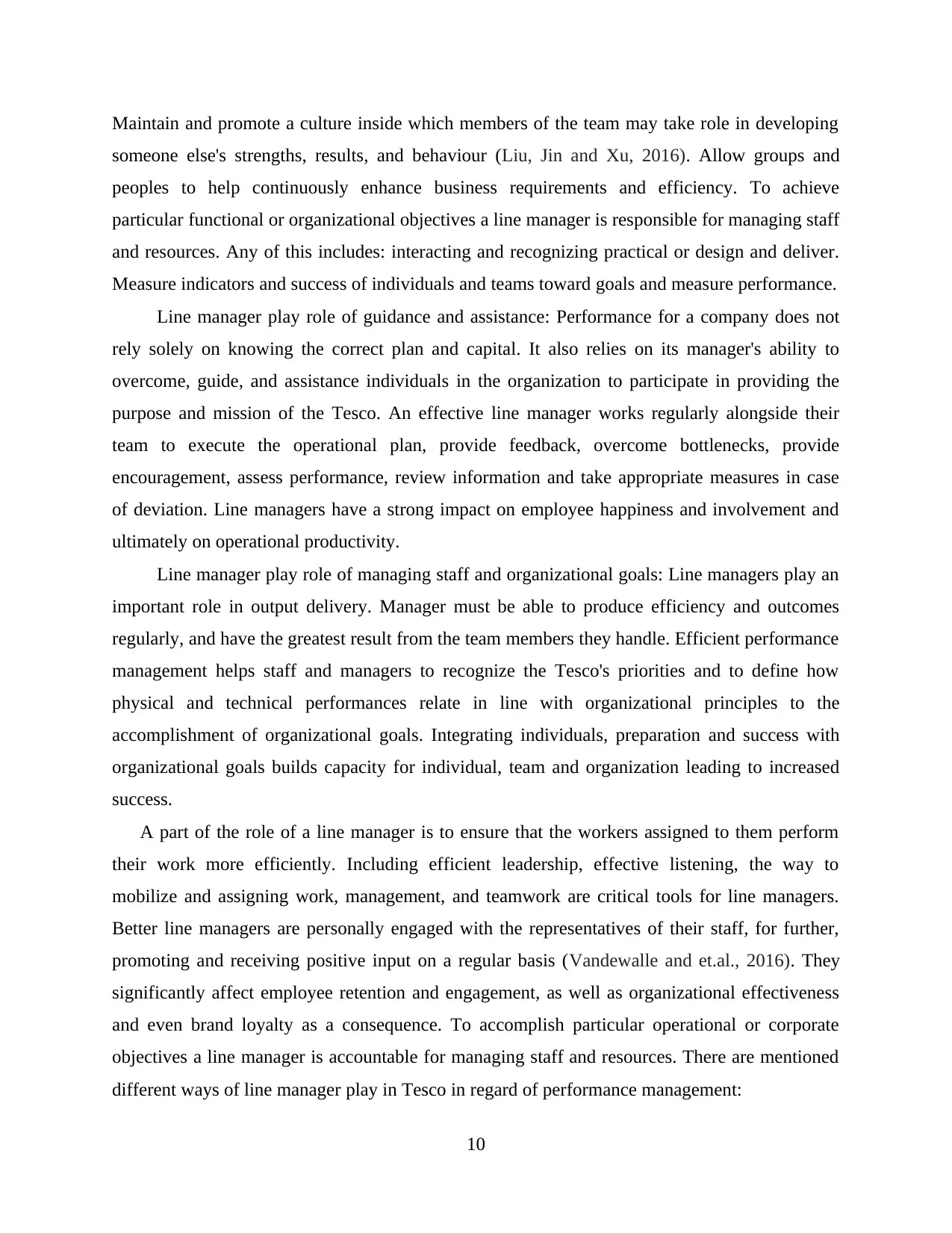
Maintain and promote a culture inside which members of the team may take role in developing
someone else's strengths, results, and behaviour (Liu, Jin and Xu, 2016). Allow groups and
peoples to help continuously enhance business requirements and efficiency. To achieve
particular functional or organizational objectives a line manager is responsible for managing staff
and resources. Any of this includes: interacting and recognizing practical or design and deliver.
Measure indicators and success of individuals and teams toward goals and measure performance.
Line manager play role of guidance and assistance: Performance for a company does not
rely solely on knowing the correct plan and capital. It also relies on its manager's ability to
overcome, guide, and assistance individuals in the organization to participate in providing the
purpose and mission of the Tesco. An effective line manager works regularly alongside their
team to execute the operational plan, provide feedback, overcome bottlenecks, provide
encouragement, assess performance, review information and take appropriate measures in case
of deviation. Line managers have a strong impact on employee happiness and involvement and
ultimately on operational productivity.
Line manager play role of managing staff and organizational goals: Line managers play an
important role in output delivery. Manager must be able to produce efficiency and outcomes
regularly, and have the greatest result from the team members they handle. Efficient performance
management helps staff and managers to recognize the Tesco's priorities and to define how
physical and technical performances relate in line with organizational principles to the
accomplishment of organizational goals. Integrating individuals, preparation and success with
organizational goals builds capacity for individual, team and organization leading to increased
success.
A part of the role of a line manager is to ensure that the workers assigned to them perform
their work more efficiently. Including efficient leadership, effective listening, the way to
mobilize and assigning work, management, and teamwork are critical tools for line managers.
Better line managers are personally engaged with the representatives of their staff, for further,
promoting and receiving positive input on a regular basis (Vandewalle and et.al., 2016). They
significantly affect employee retention and engagement, as well as organizational effectiveness
and even brand loyalty as a consequence. To accomplish particular operational or corporate
objectives a line manager is accountable for managing staff and resources. There are mentioned
different ways of line manager play in Tesco in regard of performance management:
10
someone else's strengths, results, and behaviour (Liu, Jin and Xu, 2016). Allow groups and
peoples to help continuously enhance business requirements and efficiency. To achieve
particular functional or organizational objectives a line manager is responsible for managing staff
and resources. Any of this includes: interacting and recognizing practical or design and deliver.
Measure indicators and success of individuals and teams toward goals and measure performance.
Line manager play role of guidance and assistance: Performance for a company does not
rely solely on knowing the correct plan and capital. It also relies on its manager's ability to
overcome, guide, and assistance individuals in the organization to participate in providing the
purpose and mission of the Tesco. An effective line manager works regularly alongside their
team to execute the operational plan, provide feedback, overcome bottlenecks, provide
encouragement, assess performance, review information and take appropriate measures in case
of deviation. Line managers have a strong impact on employee happiness and involvement and
ultimately on operational productivity.
Line manager play role of managing staff and organizational goals: Line managers play an
important role in output delivery. Manager must be able to produce efficiency and outcomes
regularly, and have the greatest result from the team members they handle. Efficient performance
management helps staff and managers to recognize the Tesco's priorities and to define how
physical and technical performances relate in line with organizational principles to the
accomplishment of organizational goals. Integrating individuals, preparation and success with
organizational goals builds capacity for individual, team and organization leading to increased
success.
A part of the role of a line manager is to ensure that the workers assigned to them perform
their work more efficiently. Including efficient leadership, effective listening, the way to
mobilize and assigning work, management, and teamwork are critical tools for line managers.
Better line managers are personally engaged with the representatives of their staff, for further,
promoting and receiving positive input on a regular basis (Vandewalle and et.al., 2016). They
significantly affect employee retention and engagement, as well as organizational effectiveness
and even brand loyalty as a consequence. To accomplish particular operational or corporate
objectives a line manager is accountable for managing staff and resources. There are mentioned
different ways of line manager play in Tesco in regard of performance management:
10
Paraphrase This Document
Need a fresh take? Get an instant paraphrase of this document with our AI Paraphraser
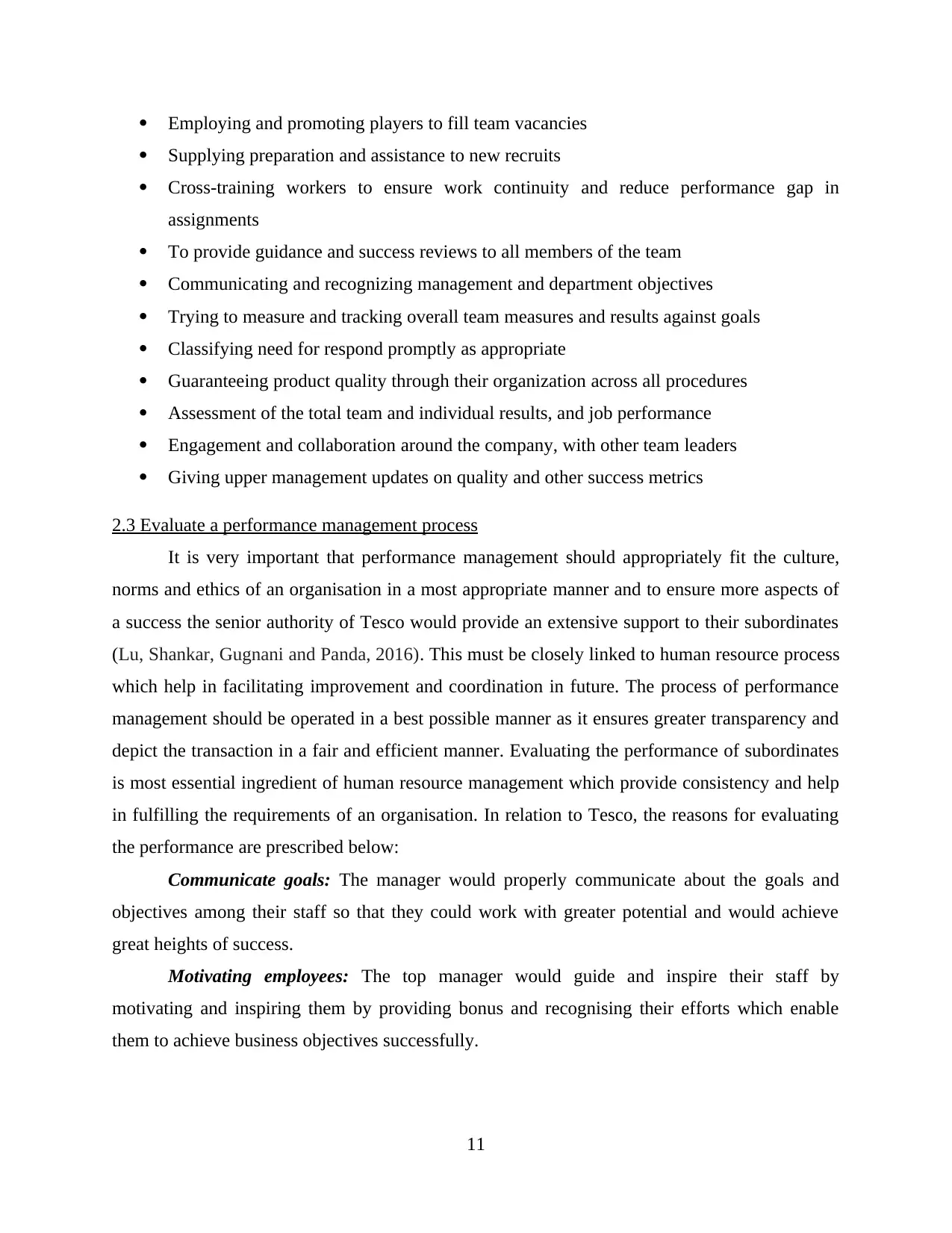
Employing and promoting players to fill team vacancies
Supplying preparation and assistance to new recruits
Cross-training workers to ensure work continuity and reduce performance gap in
assignments
To provide guidance and success reviews to all members of the team
Communicating and recognizing management and department objectives
Trying to measure and tracking overall team measures and results against goals
Classifying need for respond promptly as appropriate
Guaranteeing product quality through their organization across all procedures
Assessment of the total team and individual results, and job performance
Engagement and collaboration around the company, with other team leaders
Giving upper management updates on quality and other success metrics
2.3 Evaluate a performance management process
It is very important that performance management should appropriately fit the culture,
norms and ethics of an organisation in a most appropriate manner and to ensure more aspects of
a success the senior authority of Tesco would provide an extensive support to their subordinates
(Lu, Shankar, Gugnani and Panda, 2016). This must be closely linked to human resource process
which help in facilitating improvement and coordination in future. The process of performance
management should be operated in a best possible manner as it ensures greater transparency and
depict the transaction in a fair and efficient manner. Evaluating the performance of subordinates
is most essential ingredient of human resource management which provide consistency and help
in fulfilling the requirements of an organisation. In relation to Tesco, the reasons for evaluating
the performance are prescribed below:
Communicate goals: The manager would properly communicate about the goals and
objectives among their staff so that they could work with greater potential and would achieve
great heights of success.
Motivating employees: The top manager would guide and inspire their staff by
motivating and inspiring them by providing bonus and recognising their efforts which enable
them to achieve business objectives successfully.
11
Supplying preparation and assistance to new recruits
Cross-training workers to ensure work continuity and reduce performance gap in
assignments
To provide guidance and success reviews to all members of the team
Communicating and recognizing management and department objectives
Trying to measure and tracking overall team measures and results against goals
Classifying need for respond promptly as appropriate
Guaranteeing product quality through their organization across all procedures
Assessment of the total team and individual results, and job performance
Engagement and collaboration around the company, with other team leaders
Giving upper management updates on quality and other success metrics
2.3 Evaluate a performance management process
It is very important that performance management should appropriately fit the culture,
norms and ethics of an organisation in a most appropriate manner and to ensure more aspects of
a success the senior authority of Tesco would provide an extensive support to their subordinates
(Lu, Shankar, Gugnani and Panda, 2016). This must be closely linked to human resource process
which help in facilitating improvement and coordination in future. The process of performance
management should be operated in a best possible manner as it ensures greater transparency and
depict the transaction in a fair and efficient manner. Evaluating the performance of subordinates
is most essential ingredient of human resource management which provide consistency and help
in fulfilling the requirements of an organisation. In relation to Tesco, the reasons for evaluating
the performance are prescribed below:
Communicate goals: The manager would properly communicate about the goals and
objectives among their staff so that they could work with greater potential and would achieve
great heights of success.
Motivating employees: The top manager would guide and inspire their staff by
motivating and inspiring them by providing bonus and recognising their efforts which enable
them to achieve business objectives successfully.
11
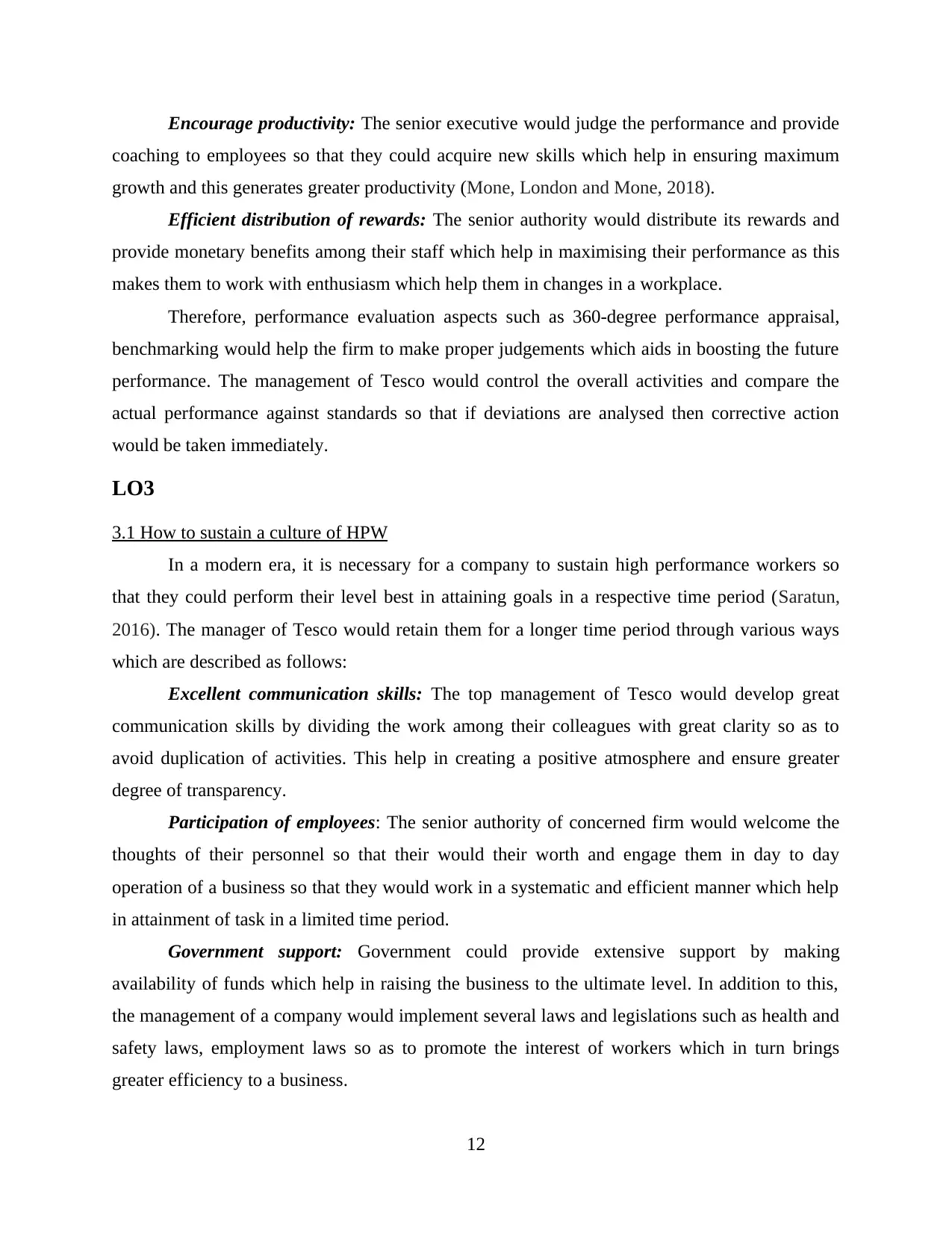
Encourage productivity: The senior executive would judge the performance and provide
coaching to employees so that they could acquire new skills which help in ensuring maximum
growth and this generates greater productivity (Mone, London and Mone, 2018).
Efficient distribution of rewards: The senior authority would distribute its rewards and
provide monetary benefits among their staff which help in maximising their performance as this
makes them to work with enthusiasm which help them in changes in a workplace.
Therefore, performance evaluation aspects such as 360-degree performance appraisal,
benchmarking would help the firm to make proper judgements which aids in boosting the future
performance. The management of Tesco would control the overall activities and compare the
actual performance against standards so that if deviations are analysed then corrective action
would be taken immediately.
LO3
3.1 How to sustain a culture of HPW
In a modern era, it is necessary for a company to sustain high performance workers so
that they could perform their level best in attaining goals in a respective time period (Saratun,
2016). The manager of Tesco would retain them for a longer time period through various ways
which are described as follows:
Excellent communication skills: The top management of Tesco would develop great
communication skills by dividing the work among their colleagues with great clarity so as to
avoid duplication of activities. This help in creating a positive atmosphere and ensure greater
degree of transparency.
Participation of employees: The senior authority of concerned firm would welcome the
thoughts of their personnel so that their would their worth and engage them in day to day
operation of a business so that they would work in a systematic and efficient manner which help
in attainment of task in a limited time period.
Government support: Government could provide extensive support by making
availability of funds which help in raising the business to the ultimate level. In addition to this,
the management of a company would implement several laws and legislations such as health and
safety laws, employment laws so as to promote the interest of workers which in turn brings
greater efficiency to a business.
12
coaching to employees so that they could acquire new skills which help in ensuring maximum
growth and this generates greater productivity (Mone, London and Mone, 2018).
Efficient distribution of rewards: The senior authority would distribute its rewards and
provide monetary benefits among their staff which help in maximising their performance as this
makes them to work with enthusiasm which help them in changes in a workplace.
Therefore, performance evaluation aspects such as 360-degree performance appraisal,
benchmarking would help the firm to make proper judgements which aids in boosting the future
performance. The management of Tesco would control the overall activities and compare the
actual performance against standards so that if deviations are analysed then corrective action
would be taken immediately.
LO3
3.1 How to sustain a culture of HPW
In a modern era, it is necessary for a company to sustain high performance workers so
that they could perform their level best in attaining goals in a respective time period (Saratun,
2016). The manager of Tesco would retain them for a longer time period through various ways
which are described as follows:
Excellent communication skills: The top management of Tesco would develop great
communication skills by dividing the work among their colleagues with great clarity so as to
avoid duplication of activities. This help in creating a positive atmosphere and ensure greater
degree of transparency.
Participation of employees: The senior authority of concerned firm would welcome the
thoughts of their personnel so that their would their worth and engage them in day to day
operation of a business so that they would work in a systematic and efficient manner which help
in attainment of task in a limited time period.
Government support: Government could provide extensive support by making
availability of funds which help in raising the business to the ultimate level. In addition to this,
the management of a company would implement several laws and legislations such as health and
safety laws, employment laws so as to promote the interest of workers which in turn brings
greater efficiency to a business.
12
⊘ This is a preview!⊘
Do you want full access?
Subscribe today to unlock all pages.

Trusted by 1+ million students worldwide
1 out of 15
Related Documents
Your All-in-One AI-Powered Toolkit for Academic Success.
+13062052269
info@desklib.com
Available 24*7 on WhatsApp / Email
![[object Object]](/_next/static/media/star-bottom.7253800d.svg)
Unlock your academic potential
Copyright © 2020–2025 A2Z Services. All Rights Reserved. Developed and managed by ZUCOL.




